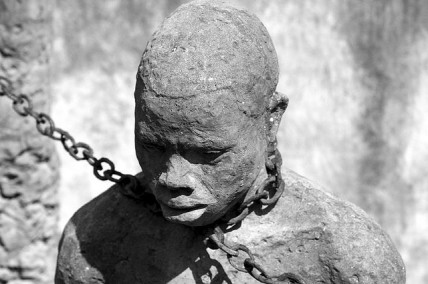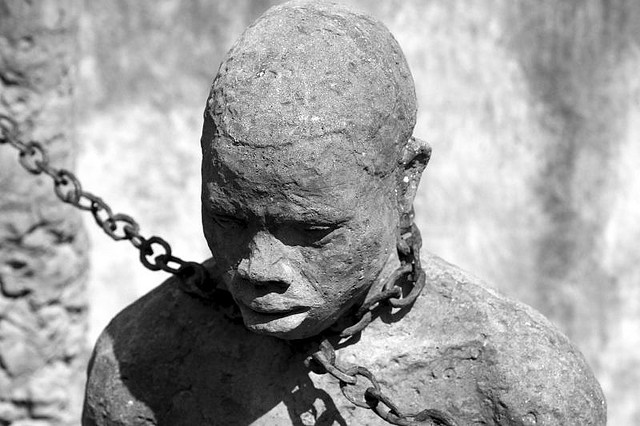
Photograph by Murky1
When the recent textile factory disasters in Bangladesh revealed the conditions in which thousands of workers toil to bring the world cheap clothing, many of us decided we could do without some of the high street brands which tacitly enable such modern slavery to flourish.
But who picks our fruit and veg, cleans the hotels rooms we stay in and the hospitals we depend on? Who is washing up in the restaurant you had dinner in last week?
A major report published yesterday gives the lie to this. It shows that forced labour – in which someone works in what are effectively slavery conditions – is a serious and growing problem within the UK itself.
This four-year study, funded by the Joseph Rowntree Foundation, which I worked on along with researchers from several universities, suggests there are at least several thousand such workers in the UK, probably many more. The International Labour Organization (ILO) has estimated there may be 880,000 people in forced labour within the EU and many millions worldwide. On this basis, the estimate from this report is very conservative indeed.
The Road to Wilberforce
We know that forced labour has been a feature of societies from the earliest written accounts, whether in Greek and Roman societies or that of the Israelites in Egypt. Britain made extensive use of forced labour – commonly known as slavery – a process which it industrialised through the transatlantic slave trade in the 17th to 19th centuries to support its own process of industrialisation and economic growth.
The slave trade was legally abolished by Britain in 1807, and abolished throughout the Empire in 1833. Although slavery continued to be a feature of Britain’s imperial possessions, it was assumed by most that it was no longer anything to do with the UK.
Although the worldwide existence of slavery and forced labour was highlighted by the ILO’s Anti-Slavery Conventions after the end of the first world war and by the historic and first Forced Labour Convention in 1930, understandings within the UK of forced labour tended to be shaped by these historic associations or, later on, by accounts of labour camps and gulags in fascist or Stalinist regimes in the 1930s and 1940s or, more recently, in authoritarian states such as Myanmar.
Trafficking and Slavery
Most discussion of modern slavery within the UK continues to focus on the issue of trafficking for sexual purposes. For example, the Centre for Social Justice’s recent report on slavery within the UK, It Happens Here, is overwhelmingly concerned with trafficking for sexual purposes, perhaps because that presents far fewer political problems for government than does forced labour with its ramifications of labour exploitation in the private economy. Similarly, although the All-Party Parliamentary Group on Trafficking claims to be concerned with forced labour, trafficking remains strongly the focus of its discussions. This is a gap which needs to be addressed.
Legally, the emergence of forced labour as a distinct but sometimes related issue to trafficking was compromised by the fact that to prove forced labour it was necessary also to demonstrate an element of trafficking and forced labour cases often then had to resort to European legal processes to achieve success.
In 2009, however, forced labour became a separate criminal offence. Trafficking and forced labour are different issues and offences, and the report found that an increasing proportion of trafficking victims identified through anti-trafficking processes actually relate to labour exploitation and domestic servitude. The latter cases are also increasing in number despite the fact that government has made it more difficult for cases to emerge because of the change in visa arrangements for domestic workers.
We Are Going Backwards
Case law is very thin at present and some cases heard to date been quite unhelpful. The nature of forced labour is still very imperfectly understood even amongst the judiciary and certainly amongst the public at large. We need, however, a clearer understanding of what forced labour looks like here and now in the UK and other so-called advanced economies.
Of course, how it is possible to use the word “advanced” in the context of a labour market which permits physical, sexual and psychological violence to be done alongside the theft of identity documents, the creation of what is effectively debt bondage, accommodation in the most appalling conditions, and working conditions which throw us back into Victorian or earlier historical epochs – is indeed a moot point.
Government – despite its rhetorical support for events such as Anti-Slavery Day – is actually creating the conditions for forced labour to flourish by visa changes, by undermining the regulatory system and cutting back the resources of those trying to police it. If it is serious, government needs to reverse its current direction of travel and take this form of modern slavery seriously – now.
By Gary Craig, Durham University
Gary Craig does not work for, consult to, own shares in or receive funding from any company or organisation that would benefit from this article, and has no relevant affiliations.
![]()




